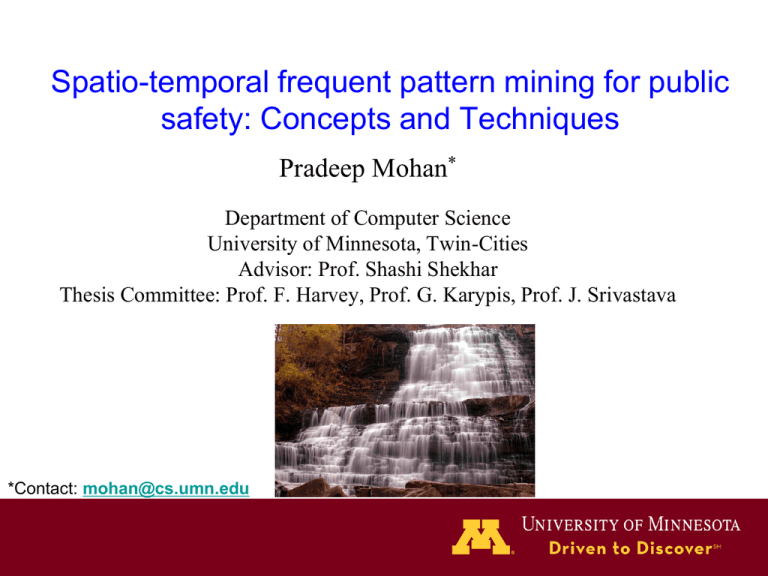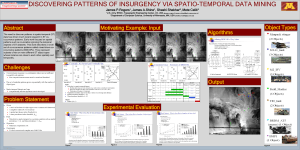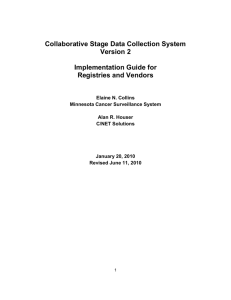Spatio-temporal frequent pattern mining for public safety
advertisement

Spatio-temporal frequent pattern mining for public
safety: Concepts and Techniques
Pradeep Mohan*
Department of Computer Science
University of Minnesota, Twin-Cities
Advisor: Prof. Shashi Shekhar
Thesis Committee: Prof. F. Harvey, Prof. G. Karypis, Prof. J. Srivastava
*Contact: mohan@cs.umn.edu
Biography
Education
Ph.D., Student, Department. of Computer Science and Engineering., University of
Minnesota, MN, 2007 – Present.
B. E., Department. of Computer Science and Engineering, Birla Institute of Technology,
Mesra, Ranchi, India. 2003-2007
Major Projects during PhD
US DoJ/NIJ- Mapping and analysis for Public Safety
CrimeStat .NET Libaries 1.0 : Modularization of CrimeStat, a tool for the analysis of crime
incidents.
Performance tuning of Spatial analysis routines in CrimeStat
CrimeStat 3.2a - 3.3: Addition of new modules for spatial analysis.
US DOD/ ERDC/ TEC – Cascade models for multi scale pattern
discovery
Designed new interest measures and formulated pattern
mining algorithms for identifying patterns from large crime
report datasets.
1
Thesis Related Publications
Cascading spatio-temporal pattern discovery (Chapter 2)
P. Mohan, S.Shekhar, J.A.Shine, J.P. Rogers. Cascading spatio-temporal pattern
discovery: A summary of results. In Proc. Of 10th SIAM International Conference
on Data Mining 2010 (SDM 2010, Full paper acceptance rate 20%)
P. Mohan, S.Shekhar, J.A.Shine, J.P. Rogers. Cascading spatio-temporal pattern
discovery. IEEE Transactions on Knowledge and Data Engineering (TKDE).
(Accepted Regular Paper, In Press ~20% Acceptance Rate)
Regional co-location pattern discovery (Chapter 3)
P.Mohan, S.Shekhar, J.A. Shine, J.P. Rogers, Z.Jiang, N.Wayant. A spatial
neighborhood graph based approach to Regional co-location pattern discovery:
summary of results. In Proc. Of 19th ACM SIGSPATIAL International Conference on
Advances in GIS 2011 (ACM SIGSPATIAL 2011, Full paper acceptance rate 23%)
Crime Pattern Analysis Application (Chapter 4)
2
S.Shekhar, P. Mohan, D.Oliver, Z.Jiang, X.Zhou. Crime pattern analysis: A spatial
frequent pattern mining approach. M. Leitner (Ed.), Crime modeling and mapping
using Geospatial Technologies, Springer (Accepted with Revisions).
Outline
Introduction
Motivation
Problem Statement
Our Approach
Future Work
4
Motivation: Public Safety
Crime generators and attractors
Identifying events (e.g. Bar closing, football
games) that lead to increased crime.
Question: What / Where are the frequent crime
generators ?
Identifying frequent crime hotspots
Courtsey: www.startribune.com
Predicting the next location of burglary.
Law enforcement planning
Question: Where are the crime hotspots ?
Predicting crime events
Predictive policing (e.g. Predict next location
of offense, forecast crime levels around
conventions etc.)
Question: What are the crime levels 1 hour
after a football game within a radius of 1
mile ?
Courtsey: https://www.llnl.gov/str/September02/Hall.html
Other Applications: Epidemiology
5
Scientific Domain: Environmental Criminology
Crime pattern theory
Routine activity theory
and Crime Triangle
Courtsey:
http://www.popcenter.org/learning/60steps/inde
x.cfm?stepnum=8
Courtsey: http://www.popcenter.org/learning/60steps/index.cfm?stepNum=16
Crime Event: Motivated offender, vulnerable victim (available at an appropriate
location and time), absence of a capable guardian.
Crime Generators : offenders and targets come together in time place, large
gatherings (e.g. Bars, Football games)
Crime Attractors : places offering many criminal opportunities and offenders may
relocate to these areas (e.g. drug areas)
6
Outline
Introduction
Problem Statement
Spatio-temporal frequent pattern mining problem
Challenges
Our Approach
Future Work
7
Spatio-temporal frequent pattern mining problem
Given :
Spatial / Spatio-temporal framework.
Crime Reports with type, location and / or time.
Spatial Features of interest (e.g. Bars).
Interest measure threshold (Pθ)
Spatial / Spatio-temporal neighbor relation.
Find:
Frequent patterns with interestingness >= Pθ
Objective :
Minimize computation costs.
Constraints :
Correctness and Completeness.
Statistical Interpretation (i.e. account for autocorrelation or
heterogeneity)
8
Illustration: Output
Cascading ST Patterns (Inputs: Spatial, Temporal Neighborhood - 0.5 miles, 20 mins, Threshold - 0.5)
Time T1
Time T2 > T1
Time T3>T2
Aggregate(T1,T2
,T3)
CSTP: P1
a
C
B
Bar Closing(B)
Assault(A)
A
Drunk Driving (C)
Regional Co-location patterns (Inputs: Spatial Neighborhood – 1 mile, Threshold- 0.25)
9
Challenges
Time
partitioning misses relationships
{Null}
A
B
Time T1
A
C
Time T2 > T1
A
B
C
Spatio-temporal Semantics
Continuity of space / time
Partial order
……….
A
B
B.2
B
B.1 C
Conflicting Requirements
Statistical Interpretation
Computational Scalability
C
A.4
B
A
B
A.3 A
C
Time T3>T2
A
C
B
A.2
B
C
A
C.1
C
C
C.2
A
C.3
……….
C.4
B
A.5
A.1
Computational Cost
A
B
A
C
B
C
B
A
C
C
B
Space partitioning misses relationships
C
B
A
C
Aggregate(T1,T2,T3)
Exponential set of
Candidate patterns
A.4
a
B
A.2
# Patterns = Exponential (# event types)
B.2
C.2
A.3
B.1
A.1 C.3
10
A
C.4
C.1
A.5
A
Our Contributions
New Spatio-temporal frequent pattern families.
Ex: Cascading ST Patterns and Regional Co-location patterns.
Novel interest measures guarantee statistical interpretation and computable in
polynomial time.
Scalable algorithms based on properties of spatio-temporal data and interest
measures.
Experimental evaluation using synthetic and real crime datasets.
11
Outline
Introduction
Problem Statement
Our Approach
Big Picture
Cascading Spatio-temporal pattern discovery
Other Frequent Pattern Families
12
Future Work
Cascading ST pattern (CSTP)
Time T1
Time T2 > T1
Time T3>T2
Aggregate(T1,T2,T3)
a
Bar Closing(B)
Assault(A)
Drunk Driving (C)
Input: Crime reports with location and time.
CSTP: P1
Output: CSTP
C
Partially ordered subsets of ST event types.
Located together in space.
Occur in stages over time.
14
B
A
Related Pattern Semantics: ST Data mining
Spatio-temporal frequent patterns
Others
Unordered
(ST Co-occurrence)
Partially Ordered
Totally Ordered
(ST Sequences)
Our Work
(Cascading ST patterns )
ST Co-occurrence [Celik et al. 2008, Cao et al. 2006]
Designed for moving object datasets by treating trajectories as location time series
Performs partitioning over space and time.
ST Sequence [Huang et al. 2008, Cao et al. 2005 ]
Totally ordered patterns modeled as a chain.
Does not account for multiply connected patterns(e.g. nonlinear)
Misses non-linear semantics.
No ST statistical interpretation.
16
15
Interpretation Model: Directed Neighbor Graph (DNG)
Nodes:
Individual Events
CSTP: P1
Directed Edge (N1 N2) iff
Neighbor( N1, N2)
and
After(N2, N1)
TimeT1
C.2
C
A.1
B
TimeT2
A
B.1
TimeT3
A.3
A.4 A.2
C.3
C.4
B.2
A.3
B.1
C.1
A.1
Bar Closing(B)
17
Assault(A)
C.1
C.2
A.5
C.3
C.4
Drunk Driving (C)
B.2
A.2
A.4
A.5
CSTP: P1
Statistical Foundation: Interest Measures
Instances of CSTP P1 : (BA, BC, AC) are
(B1A1, B1C1, A1C1)
(B1A3, B1C2, A3C2)
? ?(B1A1; A1 C2; B1 C2)
Cascade Participation Ratio : CPR (CSTP, M) :
Conditional Probability of an instance of CSTP in
neighborhood, given an instance of event-type M
ì # instances of event - type M Î CSTP ü
ý
P(CSTP | M) = í
î total # instances of event - type M þ
Examples
18
B
A
C.2
A.1
B.1
1
= 0.5
2
2
CPR(CSTP, A) = = 0.4
5
2
CPR
(
CSTP
,
C
)
0
.
5
4
CPR(CSTP,B) =
Cascade Participation Index: CPI(CSTP)
Min ( CPR(CSTP, M) ) over all M in CSTP
Example:
CPI = min{CPR(CSTP,C),CPR(CSTP, A),CPR(CSTP,B)} = 0.4
C
A.3
C.3
C.4
C.1
B.2
A.2
A.4
A.5
Analytical Evaluation: Statistical Interpretation
Spatial Statistics: ST K-Function (Diggle et al. 1995)
^
1
K AB (h,t) (S.T
)
1
A B
Iht (d(Ai,B j ),t d (Ai ,B j ))
i
j
Cascade Participation Index (CPI) is an upper bound to the ST K-Function per unit volume.
^
K AB (h,t)
= (S.T1 )2 ×
ST
1
lA ×l B
× å å Iht (d(Ai,B j ),t d (Ai ,B j ))
i
j
Example:
B.1
A.1
B.1
A.3
B.2
A.2
A.1
B.1
A.3
B.2
A.2
A.3
B.2
ST -K (B A)
2/6 = 0.33
3/6 = 0.5
6/6 = 1
CPI (B A)
2/3 = 0.66
1
1
20
A.1
A.2
Comparison with Related Interest Measures
Measure
Key Property
Frequency
Double counting of pattern instances
Maximum Independent Set (MIS) Size
[Kuramochi and Karypis, 2004]
NP Complete
Scoring Criterion for Bayesian Networks
[Neopolitan, 2003; Chickering, 1996]
NP Complete
Learning requires Prior specification
Lower bound on vertex label frequency
Frequency based interpretation.
C.2
CSTP: P1
A.1
C
B.1
C.3
A.3
C.4
B.2
19
C.1
A.2
A.4
A.5
B
Measure
Value
Frequency
3 / (What is the # of
transactions ?)
MIS
2
Lower Bound
on Frequency
min{1,2,2} = 1
A
Computational Structure: CSTP Miner Algorithm
Basic Idea
Initialization
for k in (1,2…3..K-1) and prevalent CSTP found do
Generate size k candidates.
Compute CSTP instances / Materialize part of DNG
Calculate interest measure and select prevalent CSTPs.
end
Item sets in Association rule mining
Chemical compounds/sub graphs in graph mining.
Directed acyclic graph in CSTP mining
Not part of a conventional apriori setting
21
CSTP Miner Algorithm: Illustration
CPI Threshold = 0.33
{Null}
A
B
0
A
C
B
A
0.4
B
0.8
C
0.75
C
A
C
B
0.2
C.2
0
A.1
B
A
B
C
B.1
C
C
0.4
A
B
A
0.4
A.3
0.8
C.3
C.4
C.1
B
B.2
A
C
0.4
A.2
A.4
Spatio-temporal join
22
A.5
Computational Structure: CSTP Miner Algorithm
Key Bottlenecks
Interest measure evaluation
Exponential pattern space
Computational Strategies
Reduce irrelevant interest
measure evaluation
Filtering strategies
Compute interest measure
efficiently
Time Ordered Nested Loop Strategy
Space-Time Partition Join Strategy
23
Fixed Parameters:
Spatial neighborhood = 0.62 miles and temporal
neighborhood = 1hr, CPI threshold = 0.0055
CSTP Miner Algorithm: Interest Measure Evaluation
ST Join Strategies: Perform each interest measure computation efficiently
Time Ordered Nested Loop (TONL) Strategy
Space-Time Partitioning (STP) Strategy
= volume of ST neighborhood
C.2
A.1
B.1
C.3
A.3
ST join by
plane
sweep
Space
C.4
C.1
A.5
A.2
B.2
Time
24
A.4
# Edges = 13
CSTP Miner Algorithm: Filtering Strategies
Multi resolution ST Filter:
Summarizing on a coarser neighborhood yields compression in most cases.
Space
CPI Threshold = 0.33
BA
BA
BC
BC
(0,0)
B.1 A.1 (0,2)
B.1 C.2
(1,0)
(1,2)
AC
AC
CA
CA
(1,2)(1,2)
A.1
C.2 C.1(1,1)(2,0)
A.5
(0,2)
(1,0)(1,1)
B.1 A.3 (0,0)(1,1)
B.1 C.3 A.3
C.3
(1,2)
B.2 A.2
B.2 C.1
B.2 A.4
0.80.8
(2,1)(2,0)
A.1
C.3
(1,2)(2,1)
A.3
C.4
(1,0)(2,1)
0.75
0.75
0.4
0.8
0.2 0.2
Actual Relation
Coarse Relation
27
Time
Experimental Evaluation :Experiment Setup
Goals
1. Compare different design decisions of the CSTPM Algorithm
- Performance: Run-time
2. Test effect of parameters on performance:
- Number of event types, Dataset Size, Clumpiness Degree
Experiment Platform: CPU: 3.2GHz, RAM: 32GB, OS: Linux, Matlab 7.9
28
Experimental Evaluation :Datasets
Lincoln, NE Dataset
Real Data
Data size: 5 datasets
Drawn by increments of 2 months
5000- 33000 instances
Event types:
Drawn by increments of 5 event
types
5 – 25 event types.
Synthetic Data
Data size: 5 datasets
5000- 26000 instances
Event types:
5 – 25 event types.
Clumpiness Degree:
5- 25 instances per event type per
cell.
29
Experimental Evaluation: Join strategy performance
Question: What is the effect of dataset size on performance of join strategies?
Fixed Parameters: Real Data
(CPI = 0.15, 0.31 Miles, 10
Days); Synthetic
data(0.5,25,25)
Trends: ST Partitioning improves
performance by a factor of 5-10 on
synthetic data and by a factor of 3
on real data.
30
Lincoln, NE crime dataset: Case study
Is bar closing a generator for crime related CSTP ?
Bar locations in Lincoln, NE
Questions
Is bar closing a crime generator ?
Are there other generators (e.g.
Saturday Nights )?
Observation: Crime peaks around bar-closing!
Bar closing
Saturday Night
Increase(Larceny,vandalism, assaults)
Increase(Larceny,vandalism, assaults)
K.S Test: Saturday night significantly different than normal day bar closing (P-value = 1.249x10-7 , K =0.41)
35
Lincoln, NE crime dataset: Case study
36
Outline
Introduction
Problem Statement
Our Approach
Big Picture
Cascading Spatio-temporal pattern discovery
Other Frequent Pattern Families
38
Future Work
Regional co-location patterns (RCP)
Input: Spatial Features, Crime Reports.
Output: RCP (e.g. < (Bar, Assaults), Downtown >)
Subsets of spatial features.
Frequently located in certain regions of a study area.
39
Statistical Foundation: Accounting for Heterogenity
Conditional probability of observing a pattern instance within a locality
given an instance of a feature within that locality.
Regional Participation Ratio
# instances of event type M participating in PR (RCP)
# instances of M in dataset
2
2
;RPR(
{ABC},PL2
,B)
RPR(< {ABC}, PL2 >, A) =
6
4
RPR(RCP, M ) =
Example
RPR( {ABC},PL2 ,C)
Regional Participation index
1
4
RPI(RCP) = min{RPR(RCP, M)}
Example
2 2 1 1
RPI ( {ABC},PL2 ) min , ,
4 6 4 4
Quantifies the local fraction participating in a
relationship.
40
Conclusions
Proposed SFPM techniques (e.g., Cascading ST Patterns and Regional
Co-location patterns) honor ST Semantics (e.g., Partial order, Continuity).
Interest measures achieve a balance between statistical interpretation
and computational scalability.
Algorithmic strategies exploiting properties of ST data (e.g.,
multiresolution filter) and properties of interest measures enhance
computational savings.
42
Future Work – Short and Medium Term
X: Unexplored
Input Data
Spatial
Spatio-temporal (ST)
Unordered
✔
✔
Totally Ordered
X
✔
Partially Ordered
X
CSTP discovery
Statistical
Foundation
Autocorrelation
✔
CSTP discovery
Heterogeneity
RCP Discovery
X
Underlying
Framework
Euclidean
RCP Discovery
CSTP discovery
Non-Euclidean (Networks)
X
X
Neighbor Relation
User specified
RCP Discovery
CSTP discovery
Algorithm Determined
X
X
Interestingness
Criterion
Interest measure threshold
RCP Discovery
CSTP discovery
Threshold free
X
X
Type of data
Boolean / Categorical
RCP Discovery
CSTP discovery
Quantitative data (e.g., Climate)
X
X
Pattern Semantics
43
Future Work – Long Term
Exploring interpretation of discovered patterns by law enforcement.
ST Predictive analytics, Predictive models based on SFPM and
Predictive policing.
Towards Geo-social analytics for policing (e.g. Criminal Flash mobs,
gangs, groups of offenders committing crimes)
New ST frequent pattern mining algorithms based on depth first graph
enumeration.
ST frequent pattern mining techniques that account for patron
demographic levels.
Explore evaluation of choloropeth maps via ST frequent pattern mining.
43
Acknowledgment
Members of the Spatial Database and Data Mining Research Group University of
Minnesota, Twin-Cities.
This Work was supported by Grants from U.S.ARMY, NGA and U.S. DOJ.
Advisor: Prof. Shashi Shekhar, Computer Science, University of Minnesota.
Thesis committee.
U.S. DOJ – National Institute of Justice: Mr. Ronald E. Wilson (Program Manager,
Mapping and Analysis for Public Safety) , Dr. Ned Levine (Ned Levine and Associates,
CrimeStat Program)
U.S. Army – Topographic Engineering Center: Dr. J.A.Shine (Mathematician and
Statistician, Geospatial Research and Engineering Division ) and Dr. J.P. Rogers (Additional
Director, Topographic Engineering Center)
Mr. Tom Casady, Public Safety Director (Formerly Lincoln Police Chief), Lincoln, NE,
USA
Thank You for your Questions, Comments and Attention!
44









